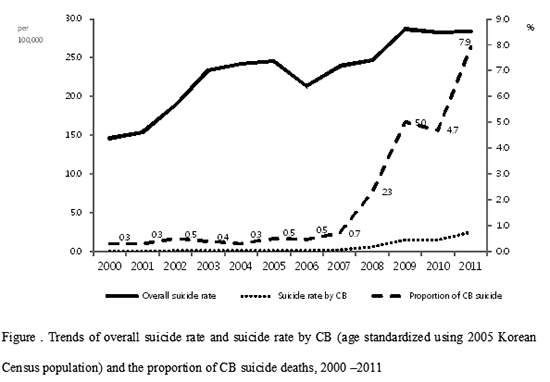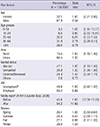Korea's suicide rate has been the highest in the Organization of Economic Co-operation and Development (OECD) countries for eight consecutive years since 2004 and is still on the rise (
1). In particular, the increase of charcoal burning (CB) suicides has contributed to this worsening situation. Before 2008, CB suicide was rare in Korea, but it has been rapidly increasing since 2008. The epidemic of CB suicides unexpectedly did not stop and has been made more prevalent over time. Consequently, the analysis of trends and risk factors of an epidemic of CB suicides can contribute to the research and policy for suicide prevention in Korea.
We hypothesized that a major risk factor of such epidemic of CB suicide would be media reports dealing with Ahn Jae-hwan (Korean actor, 36 yr old) who committed suicide by CB on 8 September, 2008. Because there have been similar cases in other countries, the first CB suicide victim in Hong Kong reportedly obtained the idea for suicide method from a Japanese film (
2). In Taiwan, the first CB suicide victim reportedly mimicked the method from a Hong Kong newspaper website (
3). Chan et al. argued that the publicity of the CB method of suicide was one of key factors for its outbreak (
4). Moreover, two studies in Korea demonstrated that those who committed or attempted suicide following a celebrity suicide imitated the same method used by the personality (
5,
6). According to Ji et al. (
5), the subsequent suicides followed by the suicide of a famous actress significantly increased before and after the event only among those who used the same method as her suicide (hanging). Based on the analysis with attempted suicides identified at an emergency department (ED) at a hospital during the 6 months before and after a celebrity suicide, attempted suicides with the same method as the celebrity's suicide were more frequently seen after the event than before.
CB regulation is more effective than hanging. In Hong Kong, a policy restricts the selling of charcoal by prohibiting the display of charcoal on supermarket shelves (
7). This study analyzed CB suicide trends in Korea from 2000 to 2011, and to explore the factors favoring the CB method over other methods of suicide, including that of media reporting of a celebrity using the CB method for suicide.
Suicide records were obtained from 2000 to 2011 (n=138,938) death certificate data from the Statistics Korea. Suicide is coded as X60-X84 in the International Classification of Diseases, 10th Revision (ICD-10). We grouped suicide methods into liquid/solid poisoning (X60-X66), CO and other gases (X67), hanging (X70), jumping from high places (X80), and others (X71-X74, X77-X79, X81-X84), in accordance with the ICD-10. CB suicide is an intentional death by carbon monoxide poisoning from burning charcoal; however, there is no specific code for charcoal burning under the ICD-10. Therefore, the code X67 was used to approximate the incidence of CB suicide in this study. Suicides by ethnic non-Koreans were also excluded in this study.
To investigate suicide trends by CB in Korea, we used CB data (n=3,394) for the duration of 12 yr (2000-2011). This time period of analysis is set as such since the CB suicide trend prior to 2000 is insignificant due to few cases and changes in the trend.
Based on collected data during the 12 yr, multivariate logistic regression was used to examine potential risk factors for CB suicide. Suicide by CB or other methods was coded as a binary outcome variable. Independent variables were gender (men/women), age groups (0-14/15-24/25-44/45-64/65 yr and higher), areas of residence (urban/rural), marital status (married/unmarried/divorced and bereaved/other), job status (employed/unemployed), the presence of media reports regarding the Ahn's suicide (before September 2008 and after September 2008), and season (spring/summer/fall/winter).
September 2008 was set as a standard date due to the clear observation of a pattern change of overall CB suicide trends before and after 2008. A popular actor in Korea, Ahn Jae-hwan, then 36 yr old, killed himself by charcoal burning and was found dead in his car on September 8, 2008. The public media covered details of his death as a leading news, exposing a large Korean population his suicide. When we analyzed media reports presenting his death during the one week after the event from 3 leading newspapers (Chosun, Dong-A, Joongang), their websites, and two national network television channels (KBS, MBC), a total of 957 articles in the same period have been publicized with the average of 136 articles per day. In particular, 597 (62.3%) of them during the first two days after his death mainly covered the event of his death, 239 (40.0%) of which contained a detailed method used for his suicide. Even 13 (76.5%) of a total of 17 TV video news on the day showed charcoal briquettes were found burned inside his car. Moreover, suicides by CB were only 3 cases a month before his death, but since then CB suicides drastically increased: 8, 12, 17, and 9 cases after the 1st, 2nd, 3rd, and 4th week from his death, respectively. All variables were analyzed as categorical variables. We used SPSS 21.0. Significance level was set at P=0.05.
Looking at the trends of suicide methods from 2000 to 2011 in Korea, the proportions of suicides by hanging and CB were continuously increasing over time. On the other hand, the proportions of suicides by poisoning was steadily declining and the shares of suicides by dropping have been about 15% without noticeable change during the study period (
Fig. 1). During the same period, overall suicide rates have continuously increased with a slight decrease between 2005 and 2006, but CB suicide rates abruptly increased from 2008 (
Fig. 2). While the proportion of CB suicide within the overall suicide rate ranged between 0.3% (17 cases) and 0.7% (84 cases) before 2008, it suddenly jumped to 2.3% (292 cases) in 2008 and continuously increased to 7.9% (1,251 cases) in 2011 (
Fig. 2).
The results of multivariate logistic regression showed that male, 15-64 age group, urban residence, single marital status (unmarried, divorced or bereaved), media reports of Ahn's suicide, and winter season were significant risk factors for CB suicide (
Table 1). The highest risk age group for CB suicide was aged 25-44 yr (OR, 6.26; 95% CI, 2.33-16.84). Males are at 2.5 times higher risk of CB suicide (OR, 2.54; 95% CI, 2.31-2.80) compared to females; there is an 18% increase in the risk of committing CB suicide for an urban dweller (OR, 1.30; 95% CI, 1.15-1.46) compared to a rural dweller. In addition, those who were unmarried (OR=1.30, 95% CI: 1.15-1.46) and divorced or bereaved (OR, 1.42; 95% CI, 1.29-1.56) were at higher risk of CB suicide than those who were married. The employed did not have greater risk of CB suicide compared to the unemployed.
The most relevant factor of CB suicide was the presence of media reports of Ahn's suicide (5 September 2008). Risk of CB suicide was 11.69 times higher after September, 2008 (OR, 11.69; 95% CI, 10.30-13.23, P<0.05) compared to the months prior. As for the seasonal factor, winter (OR, 1.22; 95% CI, 1.11-1.35) had a higher risk of CB suicide than spring and summer.
An epidemic of CB suicides since 2008 has been spreading with a slight drop between 2009 and 2010. The media reports of Ahn's suicide might contribute to outbreak of the epidemic of CB suicide since 2008. Males were more likely to choose CB suicide than females, keeping in line with previous studies in Taiwan (
8) and Japan (
9). Kanchan et al. (
10) reported that males were more likely to use fatal method to commit suicide such as hanging and poisoning. Those aged 25-44 yr were at the highest risk of CB suicide. These results are consistent with other studies in Taiwan (
8,
11) and Hong Kong (
12). According to one study in Hong Kong (
4), people who committed CB suicide were more likely to have been overly in debt, and media reports were linking over-indebtedness with the use of charcoal burning for suicide. The media reports of Ahn's suicide also attributed his death to large debts following his business failure. The 25-44 yr age groups in Korea seemed to be in concordance with those characteristics. Further studies are needed to determine the reasons for this persistent epidemic.
The possible explanation for higher CB risk for people with single marital status may be related to their circumstance in which there are no motivated guardians residing together to stop them (
13). Urban dwellers were more likely to use CB for suicide, and this result was in line with another study in Taiwan (
14). It may be because the urban dwellers can have more accessibility to charcoal products than the rural dwellers.
Unlike studies in Hong Kong (
4,
15), the employed were not more susceptible to CB suicide risk than the unemployed. These conflicting results might be from differences in study design. Our study unavoidably included students and housewives in the category of the unemployed. As for the seasonal factor, CB suicides occurred more frequently in winter than in spring and summer, which also suggests stronger preventative measures may be required during that season.
The greatest risk factor for the beginning phase of the CB suicides epidemic from 2008 might be the presence of media reports of Ahn's suicide. Following his suicide, Korean media industry reported intensively why and how to kill himself. According to the study of Beautrias et al. the media coverage of suicide in Korea has been more sensational and reckless than western European and north American countries (
16). In addition, Korea has the second highest suicide rate in the world (
17), which implies the presence of a great amount of vulnerable population. Hence, following a celebrity suicide, copycat effects on subsequent suicides might be especially pronounced in Korea.
However, the media reports of Ahn's suicide cannot be possible for explanation for the reason why suicide rates by CB have continuously increased over the consecutive years since 2008. Some possible causes for that could be raised as follows. First, the continuous media reports of CB suicides since Ahn's suicide might have given vulnerable people the impression that CB suicide was less painful and less damaging to the physical form, as suggested in the Taiwan study (
18). Additional research is needed about how the media in Korea portray CB suicide and the CB as a suicide method is perceived by vulnerable people. Second, according to a study in Hong Kong (
19), extensive and sensational media reports of celebrity suicide might lead to long-term (8 to 15 months) non-triggering effect as well as short-term (2 to 4 weeks) triggering impact on people's suicidal ideation. From the perspective of social learning theory, an individual who had memorized a celebrity's behavior and had been enough motivated could harbor suicidal ideation (
19). This long-term effect might contribute to such spreading of CB suicide epidemic. Third, given that physical availability is one of the most important determinants in the choice of suicide method (
20), no regulation of access to charcoal products might have partially contributed to the persistence of a relatively high CB suicide rate, such as in Hong Kong (
2).
Some caution is needed in interpreting the results of the present study, since current suicide method classification codes do not include a specific code for CB suicide. This indicates the high probability of under- or overestimation of CB suicide data.
Many preventive measures to curb CB suicide have already been implemented, such as charcoal not being displayed in stores. Likewise, the Korean government needs to immediately set out further CB suicide prevention measures, including effective media regulations on the reporting of such suicides.







 PDF
PDF ePub
ePub Citation
Citation Print
Print






 XML Download
XML Download